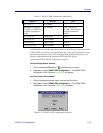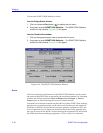
SONET Port Configuration 4-79
Bridging
Note also that these indicators simply show which error conditions have been
detected during the last 15-minute interval; they do not alter the display of the
statistics above.
Loss of Pointer
SONET uses ÒpointersÓ to compensate for frequency and phase variations as data
is being transmitted across the optical network, so that data is not delayed or lost
on the network. Basically, a pointer is a data offset value that indicates where in
the frame that the ÒpayloadÓ (user data and path overhead) begins, so that it can
be differentiated from the Òtransport overheadÓ (the information in the frame
used for transporting it across the SONET network).
A Loss of Pointer (LOP) defect occurs when either a valid pointer is not detected
in eight consecutive SONET STS-N frames, or when eight consecutive frames are
detected with the New Data Flag (NDF) set without being validly combined into
an STS-N(c)Ña concatenated STS-N signalÑto carry a larger payload.
An LOP defect is cleared when three consecutive frames are detected with either a
valid pointer and a normal NDF, or a valid concatenation indicator. Note that
incoming Alarm Indicator Signals (which are alarm messages generated by the
line and section layers that are propagated along the path to indicate a loss of
signal condition on upstream network elements) cannot contribute to an LOP
defect.
A Loss of Pointer failure is declared when a defect condition persists for a period
of 2 to 3 seconds; the LOP failure is cleared when there is no defect condition
detected for 9.5 to 10.5 seconds
Loss of Signal
Incoming SONET signals are monitored for Loss of Signal (LOS) errors, which
indicate a loss of physical signal failure (either optical or electrical) at the source
(e.g., a laser failure) or in the transmission facility (e.g., a Þber cut). Loss of signal
is detected in the data (before scrambling) by an Òall zerosÓ pattern, which
indicates that there are no light pulses for OC-N optical interfaces (on the
line-terminating equipment or a regenerator), or no voltage transitions for STS-1
or STS-3 electrical interfaces (on path-terminating equipment, such as the
FE100-Sx or APIM-2x).
A state of no transitions that lasts 2.3 µs (microseconds) or less is insigniÞcant.
A state of no transitions that lasts between 2.3 µs and 100 µs is declared an LOS
defect. The LOS defect is cleared after a 125 µs interval (the time required to
transmit one frame on a SONET network) during which no LOS defect is
detected.
If the LOS defect persists for a period of 2 to 3 seconds, an LOS failure will be
declared, an alarm indicator will be set, and an alarm message will be sent to an
Operations Systems application (responsible for overseeing the entire network).
The LOS failure is cleared when the LOS defect is absent for a period of 9.5 to 10.5
seconds.


















